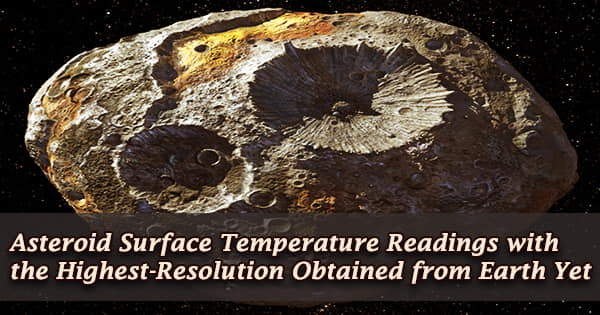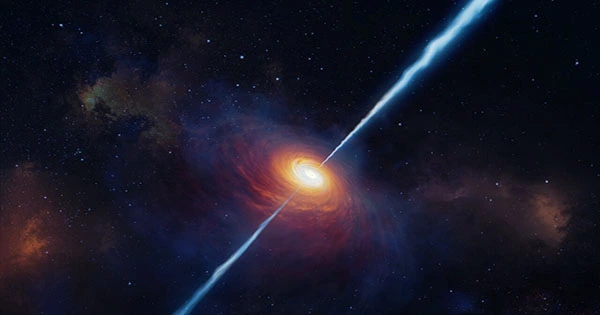The first temperature map of the asteroid Psyche, which NASA plans to visit in 2026, has been created through a detailed analysis of millimeter-wavelength emissions from the object, offering fresh insight into its surface characteristics. The results, which were published in the Planetary Science Journal (PSJ) on August 5, are a step toward unraveling the riddle of the object’s origin, which has been speculated to be a piece of the core of a doomed protoplanet by some.
Psyche is a comet that circles the sun in the asteroid belt, a donut-shaped area of space between Earth and Jupiter that includes about a million stony asteroids with diameters ranging from 10 meters to 946 kilometers. Psyche is the biggest of the M-Type asteroids, with a diameter of more than 200 kilometers. M-Type asteroids are considered to be metal-rich, and so might represent pieces of proto-planet cores that split off when the solar system developed.
“The early solar system was a violent place, as planetary bodies coalesced and then collided with one another while settling into orbits around the sun,” says Caltech’s Katherine de Kleer, assistant professor of planetary science and astronomy and lead author of the PSJarticle.
“We believe that parts of these objects’ cores, mantles, and crusts have survived in the form of asteroids. If that’s the case, it’ll be our sole chance to investigate the cores of planet-like objects up close.”
Studying such small objects so far away from Earth (Psyche wanders between 179.5 and 329 million km from Earth) is a huge challenge for planetary scientists, which is why NASA wants to send a probe to Psyche to investigate it up close.
Thermal observations from Earth, which detect light produced by an object rather than light reflected off of it, are typically in infrared wavelengths and can only give 1-pixel pictures of asteroids. However, that one pixel reveals a great deal of information; for example, it may be used to investigate the asteroid’s thermal inertia, or how quickly it warms up in the sunshine and cools down in darkness.
“Low thermal inertia is typically associated with layers of dust, while high thermal inertia may indicate rocks on the surface,” says Caltech’s Saverio Cambioni, a postdoctoral scholar in planetary science and co-author of the PSJ article. “However, discerning one type of landscape from the other is difficult.”
Data from several viewings of each surface location at various times of day give significantly more detail, resulting in a less ambiguous interpretation and a more trustworthy forecast of landscape type prior to a spacecraft’s arrival.
The Atacama Large Millimeter/submillimeter Array (ALMA) in Chile, which became fully operational in 2013, was used by De Kleer and Cambioni, as well as co-author Michael Shepard of Bloomsburg University in Pennsylvania, to gather such data. The researchers used a network of 66 radio telescopes to scan the thermal emissions from Psyche’s whole surface at a resolution of 30 km (each pixel is 30 km × 30 km) and create a 50-pixel picture of the asteroid.
This was achieved because ALMA saw Psyche at millimeter wavelengths, which are longer than infrared wavelengths (ranging from 1 to 10 millimeters) (typically between 5 and 30 microns). The researchers were able to integrate the data from the 66 telescopes to form a much bigger effective telescope by using longer wavelengths; the larger a telescope is, the greater the resolution of the pictures it generates.
The investigation verified that Psyche has high thermal inertia compared to a normal asteroid, implying that it has a thick or conductive surface. When de Kleer, Cambioni, and Shepard examined the data, they discovered that Psyche’s thermal emission is just 60% of what would be anticipated from a normal surface with the same thermal inertia.
Because the amount of metal on the surface affects surface emission, their findings imply that Psyche’s surface contains at least 30% metal. The researchers were able to detect the metal’s shape by analyzing the polarization of the radiation. A smooth solid surface produces well-organized polarized light; Psyche’s light, on the other hand, was dispersed, implying that the surface rocks are studded with metallic grains.
“We’ve known for many years that objects in this class are not, in fact, solid metal, but what they are and how they formed is still an enigma,” de Kleer says. The findings support other theories about Psyche’s surface composition, such as the possibility that it is a primordial asteroid that originated closer to the sun than it is now, rather than the core of a shattered protoplanet.
The methods outlined in this paper offer a fresh look at asteroid surface compositions. The team is now broadening their focus to include other big asteroids in the asteroid belt.
Similar research at Bloomsburg University led by Michael Shepard used de Kleer’s data in conjunction with data from other observatories, notably the Arecibo Observatory in Puerto Rico, to nail down the size, shape, and orientation of Psyche.
As a result, the researchers were able to establish which of the recorded pixels truly represented the asteroid’s surface. Shepard’s team planned to view Psyche again before the end of 2020, however, the telescope was shut down due to cable problems before the observations could be performed.
















